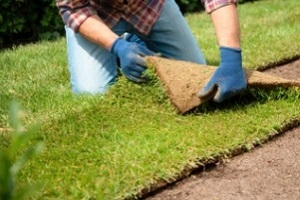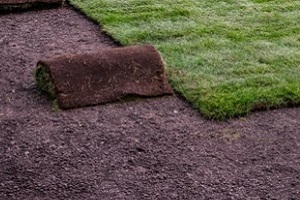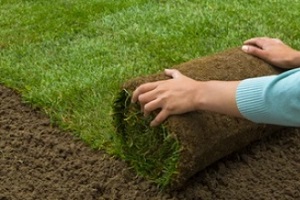 If your lawn needs an overhaul, replacing your existing grass with new sod is often the best approach. Although reseeding may be cheaper and easier, it is not going to provide you with the quick and dramatic results you seek. Sod may be slightly more labor-intensive initially, but it can give you a lush and thick lawn instantly without needing too much ongoing care.
If your lawn needs an overhaul, replacing your existing grass with new sod is often the best approach. Although reseeding may be cheaper and easier, it is not going to provide you with the quick and dramatic results you seek. Sod may be slightly more labor-intensive initially, but it can give you a lush and thick lawn instantly without needing too much ongoing care.
Preparing Your Lawn For Sod
In fact, much of the work involved in laying sod takes place during the preparation stage. Here is a look at the steps you should take to get your lawn ready for sodding.
Test Your Soil
The first step you should take before laying sod is testing your soil. You can enlist the services of a soil testing lab, which will provide you with instructions for collecting and submitting your samples and then provide you with a detailed report about the condition of your soil and how it can be amended to a healthier level. This can also point to nutrient deficiencies that need to be corrected.
Alternatively, you can purchase a soil testing kit at your local garden center. Although the results will be less detailed, it can still point you in the right direction to ensure your soil is as healthy as possible so your grass will thrive.
Kill Weeds And Existing Grass
At least two weeks before you tear up any old sod, you might want to use a vegetation killer to get rid of all the vegetation in the area where you will be sodding. Look for safe products and be sure to wear protective gear while applying it. Steer clear of garden beds and shrubs as these products will kill whatever plants they encounter.
Remove the Old Sod
If you already have sod in your yard that you want to replace, you can use a kicker manual cutter. If you need to remove a large area of existing sod, you may want to rent a power sod cutter to get the job done faster.
Amend the Soil
 Once the area has been completely cleared, it is time to apply any soil treatments that were indicated by your soil testing results. One of the most common soil amendments prior to placing sod is lime, which can increase the pH of your soil to an acceptable level and allow the grass to thrive. In some cases, it may be necessary to lower your soil’s pH, in which case you might have been advised to use sulfur. Other common amendments are compost, which can improve the structure and health of your soil, and gypsum, which can flush salts from it.
Once the area has been completely cleared, it is time to apply any soil treatments that were indicated by your soil testing results. One of the most common soil amendments prior to placing sod is lime, which can increase the pH of your soil to an acceptable level and allow the grass to thrive. In some cases, it may be necessary to lower your soil’s pH, in which case you might have been advised to use sulfur. Other common amendments are compost, which can improve the structure and health of your soil, and gypsum, which can flush salts from it.
Till the Soil
If you use soil amendments, you should till the soil a few inches deep to ensure that they are worked well into the soil. It is also a good idea to till the soil if it is compacted; your new grass will fare better if the top few inches are loosened to allow roots to penetrate more easily. However, if you do not need any amendments and your soil is loamy or sandy, you can skip this step.
Install Irrigation
If you are planning to use an irrigation system, it is best to install it right after tilling to avoid the need to tear up new grass later. This can also help make it easier to water the new lawn while it is getting established.
Remove Debris
Next, you will want to pick up any lawn debris and roots where the sod will be laid as debris can prevent root-to-soil contact. It is also a good idea to pick up stones. It may be unrealistic to pick up all of them, so focus on those that are bigger than a quarter. Then, rake the soil to make it as smooth and even as possible as uneven spots will be highlighted by the new sod.
Fertilize the Area
The last step before laying your sod is using fertilizer across the area. Be sure to use a dedicated starter fertilizer as these contain phosphorus, a mineral that is vital for root development that is not found in conventional fertilizers. Using the right product will get your grass off to the best start possible.
Tips for Laying Sod
Once you have the area prepared, you are ready to lay your sod. Many people choose to do the prep work themselves and have professionals lay the sod. However, if you are tackling this on your own, here are a few tips to keep in mind.
- Be sure to lay the first row of sod against a straight edge, such as your fence or patio.
- When beginning your second row, cut off half of the first piece so that the seams will be staggered, much like you would do when laying bricks.
- Once your sod has been installed, be sure to water the lawn thoroughly to help the soil settle.
- Water your sod every day in the beginning. Watering in the morning is ideal because the water will evaporate too quickly if you do it while it’s hot and sunny. Watering in the evening is not recommended because the sod will remain wet throughout the night, which may promote fungal disease.
- Avoid walking on the area with freshly laid sod for at least a week.
- After the first week, you can reduce your watering to every other day and decrease it further to just twice a week by the third week. From that point on, give your lawn about an inch of water per week, and slightly more during summer.
- When the grass is three inches high, mow it down to two inches. A walk-behind mower is best for new lawns as ride-on varieties may be too strong for fragile young grass.
Reach Out to Dirt Connections
For all of your lawn and soil needs, get in touch with Dirt Connections. We can deliver fill dirt and other types of dirt and soil throughout the Northern Virginia area. Reach out today to discuss your project and get a free quote.
Summary

Dirt Connections was started with one goal in mind: providing quality residential and commercial construction services to clients on time and on budget. Reach out for more information on how we can support your next project.
For your convenience our estimates are free and by appointment. Call 703-940-9949 for a free estimate today!










































